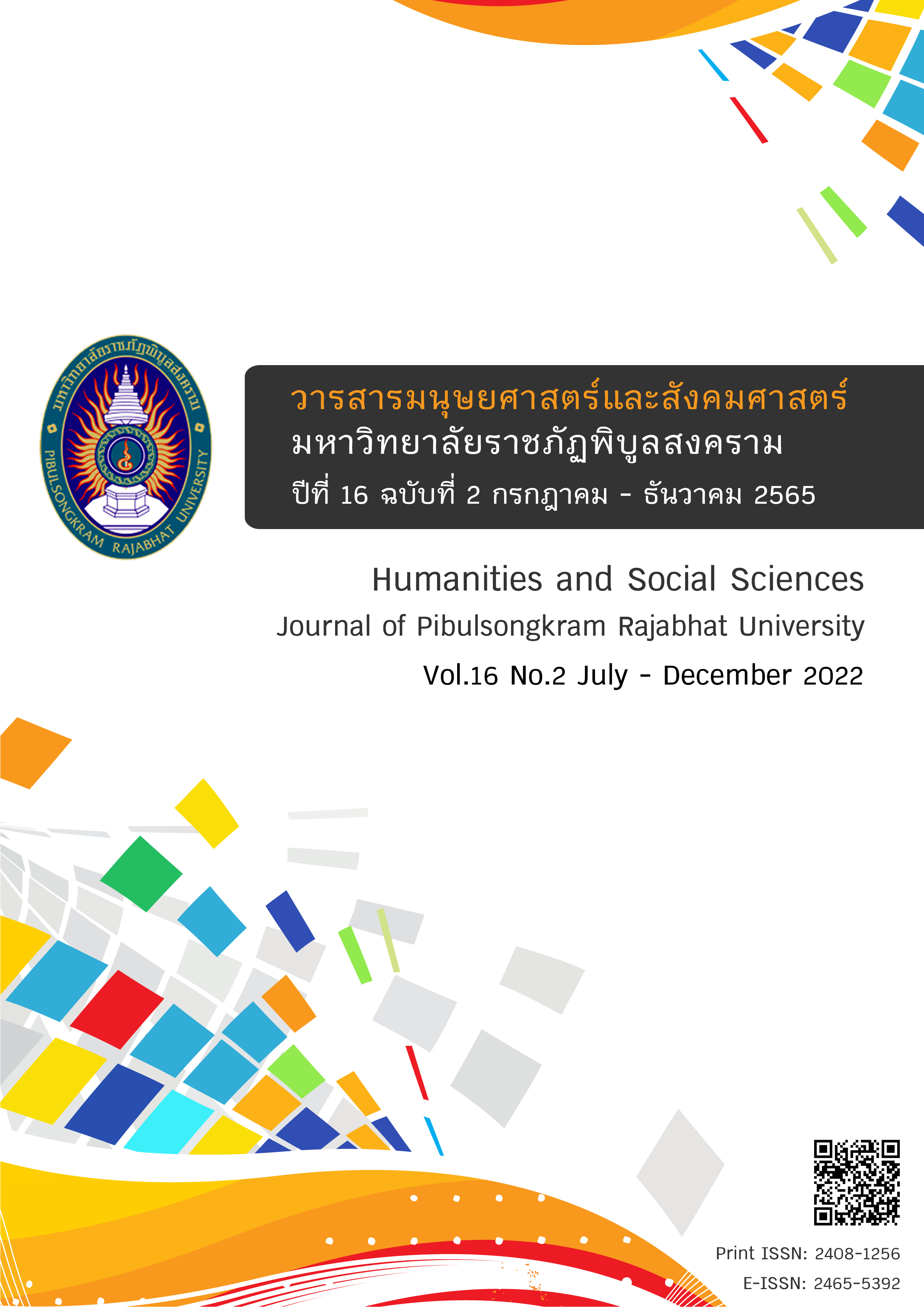Effect of Context -based Learning on Grade 10 Students’ Transfer of Learning of Force and Motion
DOI:
https://doi.org/10.14456/psruhss.2022.57Keywords:
transfer of learning, Context-based learning, PhysicsAbstract
The classroom action research aims to develop grade 10 students’ transfer of learning ability in Force and Motion concepts by using context based learning. The participants were 26 students in grade 10. The research instrument was the Force and Motion Transferability test. The students’ answers were analyzed by scoring and grouping it into five category levels, including: nonspecific transfer, content transfer, near transfer, far transfer, and creative transfer. The findings indicates that after learning through the context-based learning, the most of students are at the highest level of transfer of learning which is creative transfer (53.85%). It is followed by the 4th level, it is a far transfer (42.30%), and the near transfer level (3.85%), respectively. We also find using criticism as a tool in the learning activities can promote students’ transfer of learning. Furthermore, careful selection of the teacher’s questions used in each step of instruction can navigate students to claim up into a higher level of transfer of learning. In addition, context-based learning should begin with students’ familiar situation and then link that situation to experiment. In doing so, the students can improve their ability level of transfer of learning.
References
กระทรวงศึกษาธิการ. (2542). พระราชบัญญัติการศึกษาแห่งชาติพุทธศักราช 2542. กรุงเทพฯ: สยามสปอรต์ ซินดิเคท.
กระทรวงศึกษาธิการ. (2545). คู่มือการจัดการเรียนรู้กลุ่มสาระวิทยาศาสตร์: เอกสารประกอบหลักสูตรการศึกษาขั้นพื้นฐาน 2544. กรุงเทพฯ: องค์การรับส่งสินค้าและพัสดุภัณฑ์.
กุลธิดา สุวัชระกุลธร. (2557). การพัฒนาแนวคิดและการถ่ายโอนแนวคิดเรื่องแสงของนักเรียนชั้นมัธยมศึกษาปีที่ 5 โดยใช้การจัดการเรียนรู้แบบวัฏจักรการเรียนรู้ 7 ขั้น (วิทยานิพนธ์ศึกษาศาสตรมหาบัณฑิต สาขาวิชาวิทยาศาสตร์ศึกษา). มหาวิทยาลัยเกษตรศาสตร์. กรุงเทพฯ.
จินดา พราหมณ์ชู, เอกรัตน์ ศรีตัญญู และ ลัดดา มีศุข. (2553). ผลของการใช้กิจกรรมการเรียนรู้โดยใช้บริบทเป็นฐานที่มีต่อผลสัมฤทธิ์ทางการเรียนวิชาเคมีของนักเรียนชั้นมัธยมศึกษาปีที่ 5. วารสารศรีนครินทรวิโรฒวิจัยและพัฒนา (สาขามนุษยศาสตร์แบะสังคมศาสตร์), 2(1), 32-41.
ชรินดา สุขแสนชนานันท์. (2555). การพัฒนาแนวคิดและความสามารถในการถ่ายโอนแนวคิดเรื่อง พลังงานความร้อนของนักเรียนชั้นมัธยมศึกษาตอนต้น โดยการจัดการเรียนรู้แบบอิงบริบท (วิทยานิพนธ์ศึกษาศาสตรมหาบัณฑิต สาขาวิชาวิทยาศาสตร์ศึกษา). มหาวิทยาลัยเกษตรศาสตร์. กรุงเทพฯ.
ภัทรชา สุขสบาย. (2558). ความสามารถในการนำความรู้เรื่องของไหลไปประยุกต์ใช้ในชีวิตประจำวันและเจตคติต่อการเรียนวิชาฟิสิกส์ของนักเรียนชั้นมัธยมศึกษาปีที่ 5 โดยการจัดการเรียนรู้โดยใช้บริบทเป็นฐาน (วิทยานิพนธ์ศึกษาศาสตรมหาบัณฑิต สาขาวิชาวิทยาศาสตร์ศึกษา). มหาวิทยาลัยเกษตรศาสตร์. กรุงเทพฯ.
ยุพาวรรณ คำทา. (2557). การพัฒนาแนวคิดและความสามารถในการนำความรู้เรื่องบรรยากาศไปใช้ในชีวิตประจำวันของนักเรียนชั้นมัธยมศึกษาปีที่ 1 ด้วยการจัดการเรียนรู้โดยใช้บริบทเป็นฐาน (วิทยานิพนธ์ศึกษาศาสตรมหาบัณฑิต สาขาวิชาวิทยาศาสตร์ศึกษา). มหาวิทยาลัยเกษตรศาสตร์. กรุงเทพฯ.
เวียงชัย แสงทอง. (2553). ทรรศนะเกี่ยวกับวิทยาศาสตร์ เทคโนโลยีและสังคม แนวคิดและการนำความรู้เรื่องสารไปใช้ในชีวิตประจำวัน ของนักเรียนชั้นมัธยมศึกษาปีที่ 1 โดยการเรียนรู้ตามแนวคิดวิทยาศาสตร์ เทคโนโลยีและสังคม (วิทยานิพนธ์ศึกษาศาสตรมหาบัณฑิต สาขาวิชาวิทยาศาสตร์ศึกษา). มหาวิทยาลัยเกษตรศาสตร์. กรุงเทพฯ.
สถาบันส่งเสริมการสอนวิทยาศาสตร์และเทคโนโลยี. (2556). เกี่ยวกับ PISA (Online). https://pisathailand.ipst.ac.th/about-pisa/, 15 มีนาคม 2563.
สถาบันส่งเสริมการสอนวิทยาศาสตร์และเทคโนโลยี. (2562). ผลการประเมิน PISA 2018 (Online). https://pisathailand.ipst.ac.th/news-12/, 20 มีนาคม 2563.
สุวิทย์ เมษินทรีย์. (2560). ประเทศไทย 4.0 (Online). http://planning2.mju.ac.th/goverment/20111119104835, 4 กรกฎาคม 2562.
สุรางค์ โค้วตระกูล. (2554). จิตวิทยาการศึกษา. กรุงเทพมหานคร: จุฬาลงกรณ์มหาวิทยาลัย.
สำนักงานเลขาธิการสภาการศึกษา. (2560). แผนการศึกษาแห่งชาติ พ.ศ. ๒๕๖o- ๒๕๓๙. กรุงเทพฯ: พริกหวานกราฟฟิค.
Crawford, M. & Witte, M. (1999). Strategies for mathematics: Teaching in context. Educational Leadership, 57, 34-38.
Elliot, S.N., T.R. Kratochwil, J.L. Cook, and J.F. Traves. (2000). Educational Psychology: Effective learning. U.S.A.: McGraw-Hill.
Gagne, R.M. (1970). The Condition of Learning. 2nd ed. New York: Rinehart and Winston.
Gilbert, J. K. (2006). On the nature of context in chemical education. International Journal of Science Education, 28(9), 957-976.
Haskell, R. E. (2001). Transfer of learning: Cognition, instruction and reasoning. UK: Academic Press.
Hunter, M.C. 1995. Teach for Transfer. CA: Corwin Press.
Johnson, A.F. and S. Rutherford. 2010. “Transfer of Knowledge in Science Course for Elementary Education Majors.” Journal of College Science Teaching 3: 80-88.
Kemmis, S. & Mctaggart, R. (1998). The action research planner. Geelong, Victoria: Deakin University Press.
Kim, E. & Park, S.-J. (2002). Students do not overcome conceptual difficulties after solving 1000 traditional problems. American Journal of Physics, 70(7), 765-759.
Mestre, J. P. (2002). Probing adults’ conceptual understanding and transfer of learning via problem posing. Journal of Applied Developmental Psychology, 23(1), 9-50.
Ornek, F., Robinson, W. R., & Haugan, M. P. (2008). What makes physics difficult. International Journal of Environmental & Science Education, 3(1), 30-34.
Parchmann, I., Grasel, C., Baer, A., Nentwig, P., Demuth, R., & Ralle, B. (2006). “Chemie im Kontext”: A symbiotic complementation of a context-based teaching and learning approach. International Journal of Science Education, 28(9), 1041-1062.
Pesman, H. & Ozdemir, O. F. (2012). Approachy method Interaction: The role of teaching method on the effect of context-based approach in physics instruction. International Journal of Science Education, 34(14), 2127-2145.
Roth K. & Garnier, H. (2007). What science teaching looks like: An international perspective. Educational Leadership, 64, 16-23.
Torrance, E. P. (1965). Scientific views of creativity and factors affecting its growth. Daedalus, 94(3), 663-681.
Downloads
Published
How to Cite
Issue
Section
License
Copyright (c) 2020 Humanities and Social Sciences Journal of Pibulsongkram Rajabhat University

This work is licensed under a Creative Commons Attribution-NonCommercial-NoDerivatives 4.0 International License.
Any articles or comments appearing in the Journal of Humanities and Social Sciences, Rajabhat Phibulsongkram University, are the intellectual property of the authors, and do not necessarily reflect the views of the editorial board. Published articles are copyrighted by the Journal of Humanities and Social Sciences, Rajabhat Phibulsongkram University.









